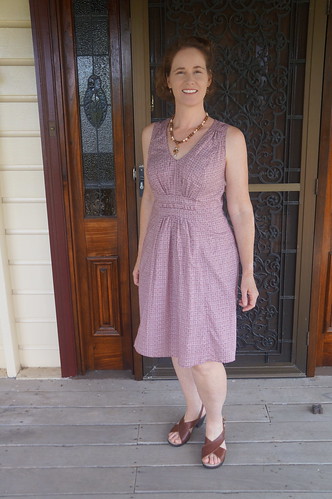Here is my new version.
The pattern is by Rachel Twomey, Vogue 1152, and I have made it, in a sleeveless version, three times before before. The first two versions are shown here, if you are interested in my fitting and design changes.
My cunning plan was to work out why only one of these previous versions became a favourite, constantly worn dress, to hopefully incorporate these features into my new dress, and to possibly reinforce the areas of the dress where wear first appeared to increase longevity of the new dress.
Why didn't it work for me in 2 of 3 earlier versions?
Version one, silk batiste:
I
wore this dress less frequently due to a too-low-for-me neckline, fabric
transparency requiring a petticoat and the unfortunate heat retaining
qualities of silk batiste as compared to cotton lawn. This is not a terrible outcome, as essentially, this dress was a trial version, although I do mourn the loss of the silk batiste, I have learnt that this is a good fabric for a light, but warm to wear petticoat, but for other garments, two layers of this fabric requires a lot of volume, for it to be comfortable to wear during spring, summer or autumn in a subtropical climate. Despite appearances, this dress does not have the necessary volume. I disposed of this version of the dress after a year or so of it languishing unworn in my wardrobe.
Version three, handwoven cotton sari fabric (fine fabric, loose weave):
I adore the third one,
but have not worn it very often after its first few weeks of existence as I discovered on the first wearing that it requires a petticoat of a
similar shade to the burnt orange main fabric and disgracefully, I
haven't yet made one. I have therefore worn it a few times with a semi visible purple petticoat as shown in the blog post, or a cream petticoat, but decided that I don't like either look. The burnt orange petticoat has been on my to do list for oh, about 2
years. I have learnt that if a dress needs a petticoat, I must make it straight away!
The dress pictured at the top of the post is not quite right. I have used a Japanese cotton lawn from Spotlight, which has a pleasing texture, and gathers nicely, but is unfortunately more transluscent than I expected.
I added piping to the front yoke seams, the neckline and the armscyes in addition to the front waistline piping called for in the pattern. I hope that this means the neckline will be resistant to fabric wear.
I self lined the centre bodice piece for robustness and opacity, and needed an additional row of gathering thread to control puffiness, but otherwise this dress is constructed very similarly to my previous versions.
Here is the inside view.
Fortunately, I had just enough fabric to squeeze in an A line, panelled petticoat, with an elastic waist in casing and a button and loop with placket closure. This skirt opening allows me to have less bulk at the waist, which I find more flattering.
In an exceptionally pleasing manner, the construction of this petticoat has instantly boosted the wearability of my orange sari dress, version 3, as the cross weave red print is not visible through the sari fabric, and the lawn is sufficiently smooth not to catch on the slightly irregular hand woven main fabric of the dress.
I have a quite reasonable dress, but what I need now, is a version that doesn't need a petticoat.
The dress pictured at the top of the post is not quite right. I have used a Japanese cotton lawn from Spotlight, which has a pleasing texture, and gathers nicely, but is unfortunately more transluscent than I expected.
Here is the inside view.
Fortunately, I had just enough fabric to squeeze in an A line, panelled petticoat, with an elastic waist in casing and a button and loop with placket closure. This skirt opening allows me to have less bulk at the waist, which I find more flattering.
In an exceptionally pleasing manner, the construction of this petticoat has instantly boosted the wearability of my orange sari dress, version 3, as the cross weave red print is not visible through the sari fabric, and the lawn is sufficiently smooth not to catch on the slightly irregular hand woven main fabric of the dress.
I have a quite reasonable dress, but what I need now, is a version that doesn't need a petticoat.








1 comment:
Your new dress looks great! Very flattering and it would be difficult to find such a dress at retail. I have wanted to make a tunic version but need to revise the side seam shaping and I've been lazy. (Unfortunately my not-an-hourglass figure looks best in a shift)
You've inspired me to tackle this project--it's such a pretty dress!!
Post a Comment